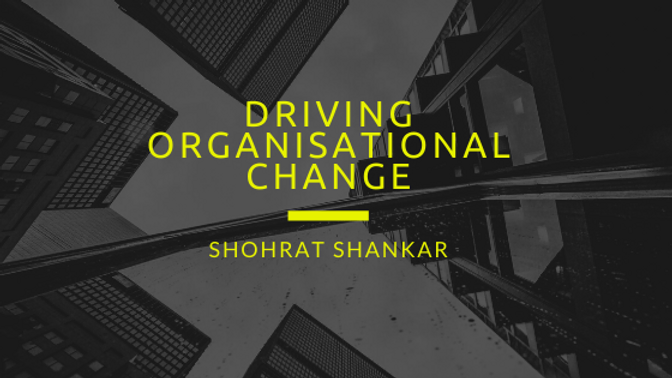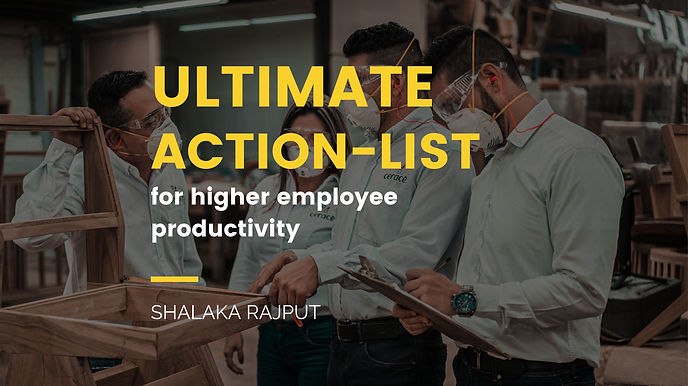

Driving Organisational Change
Organisational change is defined as “the process in which a company or organisation changes its working methods or aims, for example in order to develop and deal with new situations or markets: -Sometimes deep organisational change is necessary in order to maintain a competitive edge.”
I’ve been working with a number of companies to drive organisational change to maintain that competitive edge by achieving a variety of outcomes.
Some of the change initiatives have been:

-
Improve their Business Processes to deliver projects on time and with quality and efficiency
-
Adapt their culture to the new need driven by the ever changing demographics and get the best productivity from the employees
-
Revamp their organisational structure and leadership to drive growth and agility to deal with the dynamic demands of the consumers and technology- thus remaining relevant in a fast changing world
-
Change the way they look at their people to become a preferred place to work and thus manage the employee attrition that drains the organisation of talent and expertise
All these changes finally empower the organisation to maintain a competitive edge in one way or another.
Over the years I’ve studied various change initiatives of organisations and have seen some succeed through rapid change and agility, while others have dragged along and finally lost traction completely. In order to empower organisations, to achieve their objectives through change; here are some of the enablers and derailers observed by me.
Enablers:

-
Clear vision of the change you want to see- Just talking about wanting to change and improve is not enough. A leader must have a clear vision of the change he expects and what needs to be done to achieve this change and how long it is likely to take. Many leaders expect change to happen overnight.
-
Ensure ownership and accountability for the change across the entire leadership and management team- the change process needs all the leaders to be in alignment with the goals
and objectives of the change process. In fact, there need to be business leaders who are accountable for implementing various parts of the change process.
-
Break it down into big and small steps that need to be taken to drive the objectives- The process needs to be broken down into milestones that need to be reached and the smaller steps to reach each milestone.
-
Keep talking about the WHAT & also the HOW- While the leaders must keep talking about WHAT needs to change they should also acknowledge that there are many processes and ways of doing things (HOW) that will also need to change to reach the end goal.
-
Measure the HOW on the short term and WHAT on the long term- A change process takes time and often the final changes and results will emerge slowly. However, what is important to see is if the actions moving towards the change are being taken. Are the processes being changed, are things being done differently, are things being managed differently, are SOPs and systems coming into place? If yes, then the change is probably moving in the right direction however, the leader needs to have patience and keep applying pressure to ensure the change is complete and sticks.
-
Keep focus and pressure don’t lose hope- Even with the above happening sometimes you might not see change translating into results, at that time it's important to keep focus and discuss what more needs to be done. Often the change might require rethinking how to motivate and encourage people to translate the change into business results.
-
If you believe in the change then follow through the turbulence and apparent lack of change- When steering a business into major organisational change we have to be ready to take some hard decisions that might affect production on the short term, but enable the organisation to launch successfully in the near future. Change will lead to a turbulence in current business operations and ways of doing things and only if you push through this phase will we see the end of the storm.
-
Leaders need to engage with people to understand their views on what needs to be done to drive the change- Engage, Communicate and seek feedback to discuss the bottlenecks and challenges in implementing the change. Be open to feedback and take ownership of the change process.
Derailers:


-
Leaders who drive the initiatives don’t make any changes themselves and expect others to change around them- More often than not, the change needs to be implemented at the top first and then the team. However, a leader who doesn’t feel the need to change himself and is instead always yelling at others to change is the biggest derailer as he is not “Walking the Talk”
-
Leaders don’t look closely at the small actions being taken, instead are waiting for big achievements to recognize the change- Leaders need to recognize all the small actions and
initiatives being taken by people and not just look for the eventual big change in business results. They must recognize the HOW and not only the WHAT
-
Lack of appreciation for the small actions thus people lack encouragement and
motivation- While we all know that Business leaders are always looking for end results, they need to “Stop and Smell the roses”. They need to encourage and appreciate the small changes and actions being taken by people as that will motivate them to push further for the bigger and tougher changes.
-
Transition leads to ambiguity and sometimes leaders don’t accept any failures or mistakes thus leading people to being risk averse and unwilling to try something new- For people to be willing to try something new and different, the
leader needs to eliminate the “Fear of Failure” and create an environment that is willing to accept mistakes provided they are in the interest of driving the change and betterment of the organisation. At times like these it's also important to see the intent of the people and appreciate the intent.
-
Leaders remain focused on achieving results at any cost, thus by-passing any new process or policy if it causes any hurdles in the short term- Whenever a new system, process or SOP is brought it, there will be teething issues and during that time it is likely that it might take a little longer to get things done as people are adjusting to the new way of working. At such times the leader must resist allowing or telling people to bypass or avoid the new system in order to achieve a short term goal. As such actions will lead to a lack of commitment to the change and people falling back into the old way of doing things.
-
Leaders don’t look at and understand the emotional side of the change- Leaders need to realize that a change process is not only operational and transnational. It is emotional for many people. A Leader needs to delve deeper to understand what impact the change is having on people and be sensitive to people and the challenges they are facing at the time.
-
Often there is no clear sponsor of the change- A leader needs to take ownership of the change and not hand over the accountability of the change to consultants or the HR Team.
-
Sometimes there might be a clear sponsor, but you need a senior leader as the driver of the change





